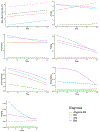Naturalistic symptom trajectories of atypical anorexia nervosa, anorexia nervosa, and bulimia nervosa in a prospective cohort study of United States college students
- PMID: 38303677
- PMCID: PMC11018494
- DOI: 10.1002/eat.24152
Naturalistic symptom trajectories of atypical anorexia nervosa, anorexia nervosa, and bulimia nervosa in a prospective cohort study of United States college students
Abstract
Objective: Research on the natural course of symptoms of atypical anorexia nervosa (AN) relative to AN and bulimia nervosa (BN) is limited yet needed to inform nosology and improve understanding of atypical AN. This study aimed to 1) characterize trajectories of eating disorder and internalizing (anxiety, depression) symptoms in college students with and without a history of atypical AN, AN, and BN; and 2) compare sex and race/ethnicity distributions across groups.
Method: United States college students who participated in Spit for Science™, a prospective cohort study, were classified as having a history of atypical AN (n = 125), AN (n = 160), BN (n = 617), or as non-eating-disorder controls (NCs, n = 5876). Generalized and linear mixed-effects models assessed group differences in eating and internalizing symptom trajectories, and logistic regression compared groups on sex and race/ethnicity distributions.
Results: Atypical AN participants demonstrated elevated eating disorder and internalizing symptoms compared to NCs during college, but less severe symptoms than AN and BN participants. Although all eating disorder groups showed signs of improvement in fasting and driven exercise, purging and depression remained elevated. Atypical AN participants showed increasing anxiety and stable binge-eating trajectories compared to AN and/or BN participants. The atypical AN group comprised significantly more people of color than the AN group.
Discussion: Findings underscore that atypical AN is a severe psychiatric disorder. As atypical AN may present as less severe than AN and BN and disproportionately affects people of color, clinicians should be mindful of biases that could delay diagnosis and care.
Public significance: College students with histories of atypical AN, AN, and BN demonstrated improvements in fasting and driven exercise and stable purging and depression levels. Atypical AN students showed worsening anxiety and stable binge-eating trajectories compared to favorable changes among AN and BN students. A higher percentage of atypical AN (vs. AN) students were people of color. Findings may improve the detection of atypical AN in college students.
Keywords: anorexia nervosa; atypical anorexia nervosa; bulimia nervosa; college mental health; natural course; symptom trajectories.
© 2024 Wiley Periodicals LLC.
Figures


References
-
- APA. (2000). Diagnostic and statistical manual of mental disorders (4th ed., text rev.). Author.
-
- APA. (2013). Diagnostic and statistical manual of mental disorders (DSM-5®). American Psychiatric Pub. - PubMed
-
- Breithaupt L, Kahn DL, Slattery M, Plessow F, Mancuso C, Izquierdo A, Dreier MJ, Becker K, Franko DL, Thomas JJ, Holsen L, Lawson EA, Misra M, & Eddy KT (2022). Eighteen-month Course and Outcome of Adolescent Restrictive Eating Disorders: Persistence, Crossover, and Recovery. Journal of Clinical Child & Adolescent Psychology, 51(5), 715–725. 10.1080/15374416.2022.2034634 - DOI - PMC - PubMed
-
- Bruch H. (1973). Eating Disorders: Obesity, Anorexia Nervosa, And The Person Within. Basic Books.
MeSH terms
Grants and funding
- K01AA024152/AA/NIAAA NIH HHS/United States
- UM1TR004360/TR/NCATS NIH HHS/United States
- R37AA011408/AA/NIAAA NIH HHS/United States
- P20AA017828/AA/NIAAA NIH HHS/United States
- P20 AA017828/AA/NIAAA NIH HHS/United States
- K02AA018755/AA/NIAAA NIH HHS/United States
- UL1 RR031990/RR/NCRR NIH HHS/United States
- K12 AR084233/AR/NIAMS NIH HHS/United States
- P50AA022537/AA/NIAAA NIH HHS/United States
- UL1RR031990/RR/NCRR NIH HHS/United States
- UM1 TR004360/TR/NCATS NIH HHS/United States
- P50 AA022537/AA/NIAAA NIH HHS/United States
- K01 AA024152/AA/NIAAA NIH HHS/United States
- K02 AA018755/AA/NIAAA NIH HHS/United States
- R37 AA011408/AA/NIAAA NIH HHS/United States
LinkOut - more resources
Full Text Sources
Research Materials

